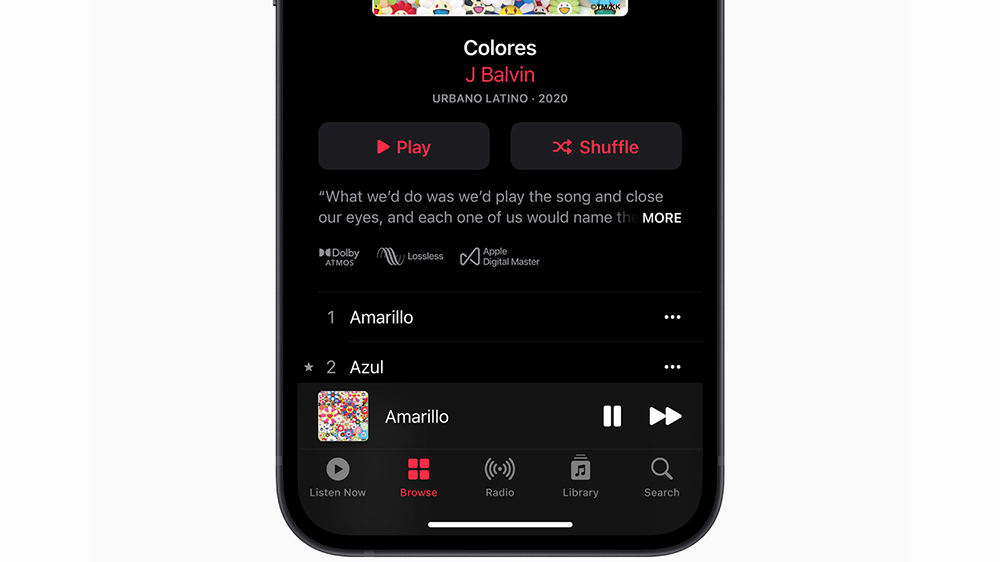When Tidal began offering hi-res audio streaming in 2017, becoming only the second streaming service to do so after Qobuz broke that ground the year before, we didn’t expect hi-res streaming to be a two-player game for quite so long.
Now though, not only have their rivals caught up but they are attempting to leapfrog the established players. And this could change the game significantly.
Higher audio quality, lower subscription prices
Apple Music has just embraced hi-res streaming with open arms – and isn’t asking people to pay a penny more for it. Its all-encompassing individual subscription plan is sticking at £10 ($10, AU$12) per month, significantly cheaper than the monthly hi-res tiers from Tidal (£20, $20, AU$24) and Qobuz (£15, $15, AU$25).
In response to Apple, Amazon has now bundled its Music HD hi-res tier, which arrived in 2019, into its standard plans rather than asking a £5 ($5) premium. That means the monthly subscription has dropped from £13 ($13) to £8 ($8) for Prime customers, and from £15 ($15) to £10 ($10) for everyone else.
Meanwhile, Deezer offers CD-quality for £15 ($15, AU$20) per month, and Spotify plans to begin offering CD-quality – no mention of hi-res so far – later this year for a fee expected to be equal to or perhaps even higher than its current £10 ($10, AU$12) per month asking price.
Maybe Apple’s bold move means that Spotify won’t ask a premium price or shun hi-res audio for its imminent Spotify HiFi tier. Realistically, Spotify’s popularity and class-leading usability mean it can probably afford not to match or undercut its rivals and still remain competitive. Even ‘only’ CD quality may be enough to keep its loyal subscribers onboard.
The wider adoption of hi-res audio streaming by big players such as Apple and Amazon has brought better sound quality into the mainstream. The fact you can have unlimited access to it for as little as £8 ($8) per month is great news for those who care for sound quality.
With Apple offering hi-res at no extra charge, and Amazon readjusting its offering accordingly, the streaming service competition has reached a crossroads, with all ways potentially pointing to tier simplicity and affordability.
Do USPs justify premium prices?
So how will the competition justify charging extra – in Tidal’s case, double? Perhaps rivals will now have to reconsider their current monthly fees, and if they don’t, hope that their unique selling points are enough.
Tidal, for example, uses MQA to power its hi-res audio streams. It’s a technology that arrived as a handy enabler for hi-res streaming back when; a method of efficiently packaging and transporting high-resolution (and therefore large) files without lossy compression.
Now that Amazon and Apple have used other methods to do this (Amazon doesn’t disclose specifics, while Apple uses its ALAC format), MQA isn’t quite as fundamental to hi-res streaming as it once seemed. However, as it is now licensed to many hi-fi brands, MQA-powered Tidal Masters tracks can be played through an increasing amount of audio hardware, via app support or Tidal Connect. If you own a compatible device that doesn’t play ball with Amazon Music HD or Apple Music, you may well be swayed to stick with Tidal.
Naturally, device support will play a part in people’s subscription decisions. While desktop and mobile apps are par for the course as far as lossless support is concerned, some services also have their own quirks. For example, Qobuz has recently become the first to bring 24-bit hi-res streaming to Sonos speakers, and its vast hi-res catalogue is also accessible via the widely supported Chromecast (which supports transmission up to 24-bit/96kHz).
Apple Music is only an attractive proposition for owners of Apple devices – and even then, its hi-res implementation isn’t without its frustrations. We wonder whether Apple Music’s hi-res streaming will be supported by AirPlay 2 (or 3!) in the future to open up the device ecosystem, or even by some new Apple-developed Bluetooth codec for inter-Apple device wireless transmission.
You can bet that Spotify HiFi will have almost universal support upon, or soon after, launch, too.
Tidal also has a burgeoning catalogue of immersive 3D tracks, thanks to its support for Dolby Atmos Music and Sony 360 Reality Audio. That said, Amazon Music HD also supports these two formats, Deezer supports the latter, and Apple will have its Dolby Atmos-powered Spatial Audio catalogue. Who knows whether Spotify has any immersive audio plans up its sleeve for its HiFi tier?
Qobuz is the audiophile’s choice for its hi-res catalogue, as well as the fact its most premium tier (Sublime) also includes discounts on hi-res downloads. But it has a comparatively limited catalogue and has long been a more niche option compared to its rivals.
Over to you, Spotify et al
Right now, Apple Music appears to offer the best-value hi-res streaming proposition for iOS users, while Amazon Music HD does that for everyone else, especially Prime members. It’s the service we’d pick right now for mobile and desktop listening.
Spotify could, of course, outdo all of them with an excellent value, hi-res HiFi tier, but even if it doesn’t, the likes of Tidal, Deezer and Qobuz are still being significantly undercut by their competition.
So will the latest moves by the streaming giants be nails in their coffins or a necessary force for change? We very much hope it’s the latter.
MORE:
Our pick of the best music streaming services
The lowdown on Spotify HiFi: quality, price, release date, and latest news
10 of the best hi-res albums on Tidal Masters
Apple Music lossless: which devices will (and won’t) play lossless, Spatial Audio
